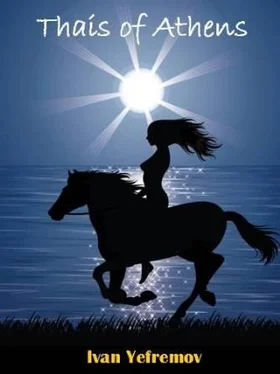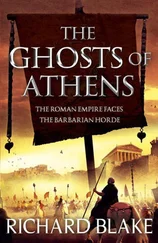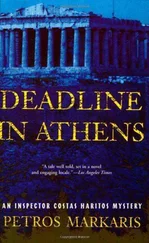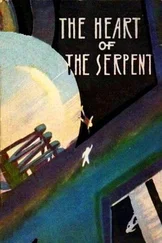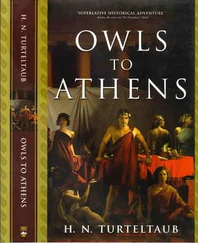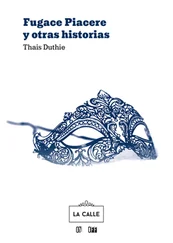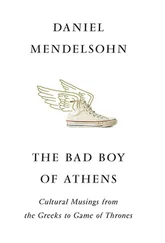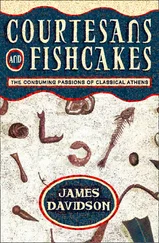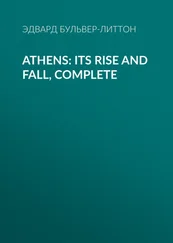Ivan Yefremov - Thais of Athens
Здесь есть возможность читать онлайн «Ivan Yefremov - Thais of Athens» весь текст электронной книги совершенно бесплатно (целиком полную версию без сокращений). В некоторых случаях можно слушать аудио, скачать через торрент в формате fb2 и присутствует краткое содержание. Издательство: Electronic edition, Жанр: Историческая проза, на английском языке. Описание произведения, (предисловие) а так же отзывы посетителей доступны на портале библиотеки ЛибКат.
- Название:Thais of Athens
- Автор:
- Издательство:Electronic edition
- Жанр:
- Год:неизвестен
- ISBN:нет данных
- Рейтинг книги:3 / 5. Голосов: 1
-
Избранное:Добавить в избранное
- Отзывы:
-
Ваша оценка:
- 60
- 1
- 2
- 3
- 4
- 5
Thais of Athens: краткое содержание, описание и аннотация
Предлагаем к чтению аннотацию, описание, краткое содержание или предисловие (зависит от того, что написал сам автор книги «Thais of Athens»). Если вы не нашли необходимую информацию о книге — напишите в комментариях, мы постараемся отыскать её.
Thais of Athens — читать онлайн бесплатно полную книгу (весь текст) целиком
Ниже представлен текст книги, разбитый по страницам. Система сохранения места последней прочитанной страницы, позволяет с удобством читать онлайн бесплатно книгу «Thais of Athens», без необходимости каждый раз заново искать на чём Вы остановились. Поставьте закладку, и сможете в любой момент перейти на страницу, на которой закончили чтение.
Интервал:
Закладка:
Three royal tombs were utterly striking: the pyramids with their titanic Sphinx, seventy stadiums down from Memphis. Thais had heard much about the pharaohs’ tombs, but until she saw them, she could never have imagined their true magnitude. The pyramids were geometrically perfect mountains dressed in mirror smooth stone tiles, set together so tightly that seams between the stones were barely noticeable. During the morning hours each of the large pyramids reflected a vertical pillar of rose colored light into the gray sky. As the sun rose, the mirror sides of the stone giants burned brighter, until each pyramid turned into a star — a focus of four blinding streams of light stretched across the desert to the four points of the world. At sunset broad columns of red fire stood above the tombs of the pharaohs, piercing the purple evening sky. Below them, the outlines of the god kings of the Black Earth (as Egyptians called their country) burned like sharp fiery blades. These incomparable structures seemed to be the work of titans, although knowledgeable people assured Thais that the pyramids had been built by common slaves.
“If a man is frequently and severely beaten,” a priest from Heliopolis told her, grinning cynically, “he will do anything that might seem incomprehensible to his descendants.”
“These are the largest structures in Egypt. That means people here were beaten harder than anywhere else,” Thais said, her voice lowered with menace.
The priest glanced at her sharply then pursed his lips.
“Do Helenians not beat their slaves?”
“Of course they do. But those who do have a bad reputation.”
“Are you trying to say, woman …” the priest started.
“I am not trying to say anything,” Thais objected quickly. “Each country has its own tradition, and one must live there a long time in order to understand them.”
“Then what don’t you understand?”
“The great complexity of power. In my country everything is simple. You are either free or a slave. If you are free, then you are rich or poor, famous for arts, or knowledge, or military and athletic prowess. And here, every free person is a tiny step higher or lower than the next. One is allowed something, the other less, and the third person nothing at all. Everyone is filled with jealousy, everyone bears a grudge. It seems that everyone is a slave locked in a big cage between two deserts. I haven’t met many people here who have visited other countries of the Ecumene. Although, it is fair to say I haven’t been here very long.”
“You are observant, Helenian. Even too much so,” the priest. He spoke Greek with light clicking, allowed a threat to slip into his words. “I will leave you now.”
Egyptian temples struck Thais by their sharp contrast with those of Hellas. Each Greek temple, with the exception of perhaps the most ancient ones, stood in an elevated spot, open, graceful and light, as if it were about to take off into space, sea and sky. Statues of goddesses, gods and heroes drew admirers to themselves with their miraculous beauty. The boundary separating gods from mortals seemed thin, almost unnoticeable. One could believe that gods leaned forth in order to better hear the prayers addressed to them, and were about to step off their pedestals, as they did in those legendary times, when they bestowed their attention upon all people — from farmers to warriors, instead of just priests.
Temples of Egypt were gloomy, squeezed between thick walls and rows of massive columns. They were covered by inscriptions and a multitude of pictures and signs. Each sanctuary hid its visitors from the vastness of earth and sky, from wind and clouds, flowing creeks and splashing waves, from human songs and voices. Dead, menacing silence reigned in the temples, as they descended unnoticeably underground. Dying light faded with each step, and gloom grew thicker. It was as if a visitor descended into the darkness of past centuries. While only a thin boundary separated mortals from the dwellers of the light-filled peak of Olympus in Hellenic temples, here one felt but a step away from the kingdom of Hades, where the souls of the dead have long since wandered in the dark.
This sensation of the endless night of death oppressed the young woman. Thais hurried away, toward light and life. Temples and palaces were guarded by frighteningly identical statues of lions with human or ram heads. The image of the Sphinx, a terrible female strangler from Hellenic myths, took on a male gender in Egypt and became a favorite symbol of strength and power. Not only the Sphinx, but all Egyptian deities, including the most important ones, wore animal and bird guises, combining human and animalistic features. Thais had seen Egyptian amulets, statuettes and jewelry before, but had always thought Egyptians used the images of animals only to express a particular purpose of a talisman or a knickknack. As it turned out, it was rare for the gods to wear fully human guise. More often the faithful bowed before half-people, half-beasts and birds, sometimes grotesquely ugly, like the hippopotamus-like Tueris.
Hippopotami and crocodiles disgusted and frightened Thais. Revering them as deities seemed unworthy to the Athenian. The others were just as unattractive: Anubis with the head of a jackal, Tot with a long beak of an ibis, mean lioness Sekhmet, Hathor the cow, and Khnum the ram. Huge statues of birds of prey: kite Ra and hawk Horus, looked much more imperious as they were portrayed in the ancient times.
The complex hierarchy of gods remained just as confusing to the Athenian, as did the multitude of honors and titles and the complicated ladder of Egyptian societal relations. Each moderately sizable city was overseen by its own god. Large temples which owned wide lands and multitudes of slaves also gave their preference to one of a score of gods. Deities changed and lost their supremacy many times over the millennia.
The thing that continued to surprise Thais the most was the animal likeness of the gods revered by people, whose wisdom and secret sciences were so admired by Helenians. She knew that the great scholars of Hellas: Solon, Pythagoras and Plato, all studied in Sais. Herodotus, too, acquired a wealth of knowledge in Egypt. If this were so, then how could citizens of Egypt bow before monsters like crocodiles, which were senseless and disgusting creatures? Could they not express the essence of a deity by some other means rather than setting the head of a jackal or a kite onto a human body? Had the Egyptians not been such skilled artists, one might think they didn’t know of other ways to express the divine spirit.
Soon Thais saw a living god: sacred bull Apis, the embodiment of Ptah. He was the main god of Memphis. Using twenty-nine signs, priests had found Apis among thousands of bulls, grazing peacefully in the meadows of the country, and honored it like a god till death. Then they found a new embodiment, while the dead one was embalmed akin to the other living god, the Pharaoh. Mummies of sacred bulls were buried in a huge temple named Serapeyon, which was guarded by hundreds of stone sphinxes.
One could trace many generations of bulls by the tables inscribed on the walls of their burial chambers. There were so many bulls from ancient times that Serapeyon was already half-filled with sand.
Adoration of a black bull with a white spot on its forehead still flourished in Memphis. Local Greeks tried to humanize the cult of Apis by merging it with Osiris, under the name of Serapis.
Hellenic religion had long since departed from the primeval animal worship. Even on Crete, whose age was almost equal to that of
Egypt, the giant sacred bulls were only honored as symbols of Poseidon. They were killed as sacrifices at the altars and on game platforms. In Egypt, however, Apis was considered a real god, just like the loathsome crocodile or the reed cat howling in the night.
Читать дальшеИнтервал:
Закладка:
Похожие книги на «Thais of Athens»
Представляем Вашему вниманию похожие книги на «Thais of Athens» списком для выбора. Мы отобрали схожую по названию и смыслу литературу в надежде предоставить читателям больше вариантов отыскать новые, интересные, ещё непрочитанные произведения.
Обсуждение, отзывы о книге «Thais of Athens» и просто собственные мнения читателей. Оставьте ваши комментарии, напишите, что Вы думаете о произведении, его смысле или главных героях. Укажите что конкретно понравилось, а что нет, и почему Вы так считаете.
